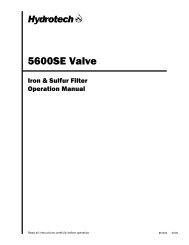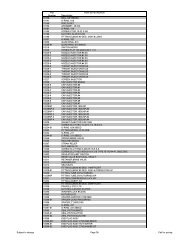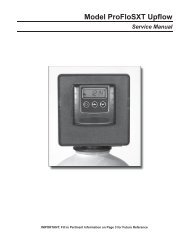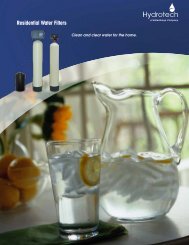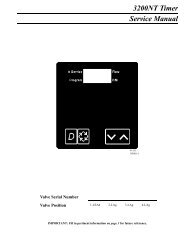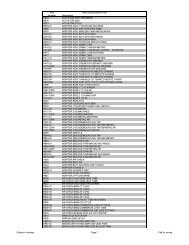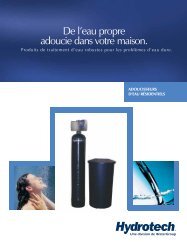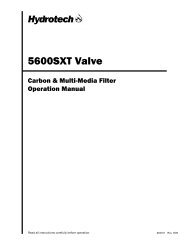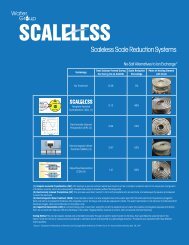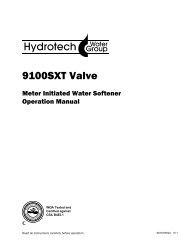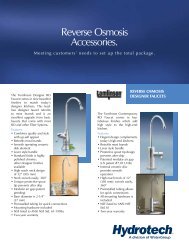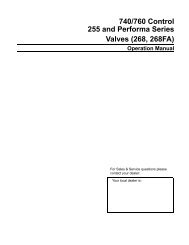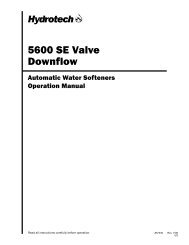HY US 01 Introduction.qxp - Hydrotech
HY US 01 Introduction.qxp - Hydrotech
HY US 01 Introduction.qxp - Hydrotech
You also want an ePaper? Increase the reach of your titles
YUMPU automatically turns print PDFs into web optimized ePapers that Google loves.
Water Analysis<br />
For correct sizing and application of water<br />
conditioning equipment, a water analysis is required.<br />
A basic water analysis includes tests for the following:<br />
• Hardness<br />
• Iron<br />
• Manganese • pH<br />
• TDS<br />
Water samples should be taken as near the source as<br />
possible and represent the average water condition.<br />
Clean containers must be used. When performing the<br />
analysis, the test equipment must be clean and rinsed<br />
with the test water and the test water should be<br />
between 68°F and 77°F (20°C and 25°C). Use rubber<br />
stops as supplied. Do not use your fingers as<br />
contaminants and acids could affect test results.<br />
Additional tests can be performed for tannins and<br />
hydrogen sulfide (H2S). The test for H2S must be<br />
performed on-site for accurate results. Special tests<br />
can be performed for chlorides, sulfates and alkalinity<br />
by specified laboratories. If it is suspected the water<br />
supply is contaminated with coliform bacteria or<br />
nitrates, a sample must be collected in an approved<br />
sterilized container and submitted to a government<br />
approved laboratory. Iron bacteria will not be detected<br />
with the standard iron test and should be tested for by<br />
a government approved laboratory.<br />
If TDS is over 1000 ppm and hardness is less than<br />
30% of the TDS, a complete water analysis should be<br />
performed to discover what other contaminants exists<br />
in the water.<br />
If a contaminant exceeds the limits detectable by any<br />
test method, the raw water sample can be diluted with<br />
distilled water until a reading can be taken.<br />
A calculation must then be performed to determine the<br />
actual degree of contamination.<br />
All test chemicals are subject to age and extreme<br />
temperatures. Proper storage techniques and expiry<br />
dates should be observed.<br />
The Water Analysis Report shown on the next two<br />
pages must be completed accurately to determine the<br />
correct equipment to recommend for the water<br />
problem(s) being experienced.<br />
Hard Water<br />
Water with a total hardness of 1.0 gpg or more as<br />
calcium carbonate equivalent.<br />
Less than 1.0 gpg .............. Soft<br />
1.0 - 3.5 gpg ...................... Slightly hard<br />
3.5 - 7.0 gpg ...................... Moderately hard<br />
7.0 - 10.5 gpg .................... Hard<br />
More than 10.5 gpg ............ Very hard<br />
Hardness<br />
A characteristic of natural water due to the presence<br />
of dissolved calcium and magnesium. Water hardness<br />
is responsible for most scale formation in pipes and<br />
water heaters and forms insoluble “curd” when it<br />
reacts with soaps. Hardness is usually expressed in<br />
grains per gallon (gpg), parts per million (ppm) or<br />
milligrams per liter (mg/l) all as calcium carbonate<br />
equivalent.<br />
Soft Water<br />
Any water which contains less than 1.0 gpg (17.1<br />
mg/l) of hardness minerals, expressed as calcium<br />
carbonate equivalent.<br />
Softened Water<br />
Any water that is treated to reduce hardness minerals,<br />
expressed as calcium carbonate equivalent.<br />
8 <strong>Hydrotech</strong>



